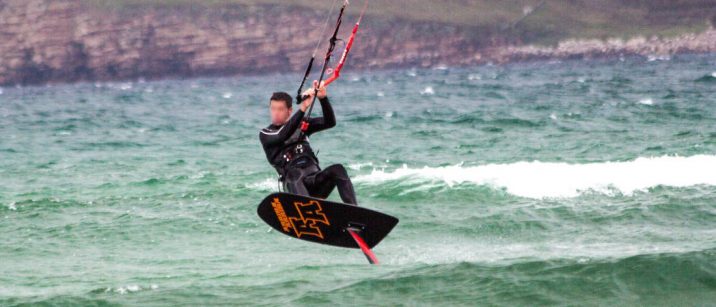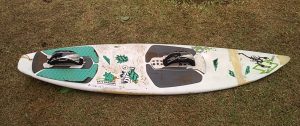Many kitesurfers who used to wait for strong wind are now speeding around in much lighter breezes, thanks to the efficiency of kite foils.
If you use standard inflatable kites or are a beginner, you may need at least 12-13 knots of wind to kite foil. But with light-wind specific kites and good foiling skills, it’s possible to foil in as little as 6 knots.
Here are a few examples of light wind kites for foiling with their estimated minimum wind. Keep in mind this number depends on kite size, board size, foil size, rider weight, skill level and wind / weather / water conditions.
| Light wind kite | Kite type | Minimum wind |
| Flysurfer Soul | Foil kite | 6 knots (21m) |
| Airush Ultra | LEI | 7.5 knots (14m) |
| Cabrinha Contra | LEI one strut | 7 knots (15m) |
| Cloud | Strutless | 7 knots |
| Gong | Strutless | 7 knots (12m) |
You can start foiling with the same kites that you usually kite with. But your lower wind limit will depend on your skills, the qualities of the air in your location, and the equipment you use.
How much wind is fun/safe to foil in?
The magic of hydrofoiling lies in the fact that the foil wing produces such little drag as it slices through the water. This makes it possible to be up and foiling with very little pull from the kite.
A moderately skilled kitefoiler can enjoy riding around in about 8-9 knots, without too much fear of getting into trouble.
But be careful: In marginally light winds, it only takes a small drop in windspeed to go below the minimum threshold a kite needs to stay in the air.
You might not even notice the wind dropping. With the apparent wind created by your riding speed, the wind will feel stronger than it is— until you come to a stop, crash, or slow down to change tacks.
Air and Wind Quality
When talking about windspeeds at the lower end of your wind limit, there’s more to consider than just the number of knots on the wind meter. The quality of the air and the wind have a significant effect on the number of knots you’ll need.
In light and variable winds, you’re more vulnerable to lulls. It may take only a minor lull of 2-3 knots for your kite to drop out of the sky.
In addition, the density of the air in a given location also makes more difference than many people realize.
Denser air has more mass per cubic meter, and exerts a greater force on the kite. In lighter air, you will need a higher windspeed to achieve the same results.
Humid air weighs less than dry air. Warm air weighs less than cool air. And at higher altitudes, the lower air pressure means that the air weighs less than it does at sea level.
All this means that the 10 knots that are easy to ride in at your home area may not be enough somewhere else. That’s why people sometimes go on a kite trip to a tropical location, only to find that they need more wind to fly their kites.
Minimum wind for foiling: kite type & size
Two important light-wind considerations are the choice of kite, and the kiter’s ability to fly it.
Lower winds below 10 knots require a lighter, more responsive kite that can generate the power needed to waterstart. After that, it takes far less power to keep you up and riding on the foil.
Almost any kite will be able to stay in the air in 10 knots, but flying characteristics vary widely among styles and designs of kite.
Many kite brands offer light-wind specific inflatable – LEI or “leading edge inflatable” – kites. These typically have lighter construction and fewer struts.
The Airush Ultra, Cabrinha Contra, and the Ocean Rodeo Flite are good examples. All have official wind ranges starting from about 8 knots. Some kites have no struts at all, like the Cloud from Board Riding Maui, or the Gong Strutless.
But the ultimate choice of kite for less than 10 knots is the foil kite, also called the ram-air kite. These are the kites that look like a paraglider wing or parachute, with cells and a more complex bridle system.
They are the lightest kites available, can fly in the least wind, and are more aerodynamically efficient than inflatables. The Flysurfer Soul has a posted wind range of 6 knots and up, for a 75kg rider.
Don’t be confused by the word “foil.” It has two meanings – one refers to the hydrofoil wing under the board, and the other to these soft-cell kites.
The kite size you’ll need also depends on body weight. For an “average” rider with a weight of about 75-80 kilos, a 12-13m kite will be adequate in the lower wind ranges.
Relaunching
Kiters often say that “if there is enough wind to keep a kite in the air, you can kitefoil”. With the right kite and the right hydrofoil, this might be true, provided if you have the skills.
But are you absolutely sure that you will never drop your kite onto the water? If you can’t relaunch, you may be in for a long swim back. And performing a self-rescue with a foilboard and in light wind isn’t easy.
A more practical rule of thumb would be to make sure you have enough wind to relaunch your kite. This usually takes several more knots than it does to keep it in the air.
Within the 2-3 meters of the surface of the water, the windspeed is significantly less than higher up. This “wind gradient” is caused by friction as the air moves over the water.
In borderline light winds, it could mean the difference between being able to get your kite back up in the air or not.
Exactly how much wind you need to relaunch your kite will depend on the type of kite, and of course your relaunching skills. If you are in water shallow enough that you can stand, you can relaunch in 3-4 knots less than in deep water.
Foil kites are the easiest to relaunch in borderline light winds – the Flysurfer Soul can relaunch in 6-7 knots. Light wind specific inflatables the next easiest, but nearly any pump kite is tricky to relaunch in 8 knots or less.
For some kiters, no-strut kites can be more difficult to relaunch. But strutless kite designs vary widely across brands, and some are easier than others.
Minimum wind for foiling: board & wing size
A bigger board makes things much easier for beginners to water start and take off on the foil. The Slingshot Alien Air, 4’8” by 21.5” wide, with about 40 liters of volume is a good example.
Later, as the foiler’s skill improves, a large size board generally becomes too cumbersome. That’s why you often see very good foilers on tiny boards about the size of a lunch tray.
Besides this, the size of the hydrofoil wing itself has a far greater impact on low-wind performance and ease of riding than the size of the board.
Only a few years ago, most kite foils on the market were in the 600-800 square centimeter range. These hydrofoils were difficult to ride, and needed a significant amount of speed for the foil to generate enough lift.
Nowadays, larger hydrofoils are more common. They can allow you to waterstart and ride with less power from the kite (smaller kite, lower wind), and at slower speeds. 1200 square centimeters is a good size to start with.
The shape of the foil is also important. Given the same surface area, a low-aspect foil will start to generate lift at a slightly lower speed and be more stable to ride. It will also have a lower top speed limit.
Low wind foiling: larger LEI kite vs foilkite

If you decide to become an ultra light-wind foiler, you may be faced with the decision of whether to buy a large foil kite or an even larger inflatable kite.
Foil kites have complex bridle systems and different flying characteristics than inflatables. Some kiters may find this intimidating at first.
On the other hand, foil kites tend to be more aerodynamically efficient than inflatable kites, generating more lift per square meter.
Light-wind inflatable designs, on the other hand, have improved to the point where their advertised lower wind ranges are within 3-4 knots of a foil kite.
That said, almost any inflatable kite, regardless of the number of struts, becomes more difficult to relaunch in less than 10 knots. So in ultra light wind conditions, a foilkite can be a better choice.
One trade-off with foilkites is that they tend to turn more slowly. As always, it comes down to your skills in handling the equipment. In lighter wind, it takes more technique and precision to create the power needed to ride.
A good kiter can “squeeze” more power out of their kite with more efficient powerstrokes, and by looping the kite.
Your skill with the hydrofoil comes into play as well. Learning how to pump the foil, for example, is essential for waterstarting. It helps you get going with less pull from the kite, and allows you to use a smaller kite.
Final Words
Learning to kitefoil is worth the time and effort of becoming a beginner again. And yes– you’ll feel like a beginner again at first. It takes time.
It’s best to start learning in at least 13-14 knots. Start with a big hydrofoil on a big board, and enough power in your kite that you would normally need on your twintip.
Then, as your skills progress you can move to lighter winds, with kites that are designed for lower wind ranges and foils designed for higher speeds.
***
Photo credits:
Featured image: “paul2.jpg” (CC BY 2.0) by silverback44
(2) “paul on foil1.jpg” (CC BY 2.0) by silverback44



